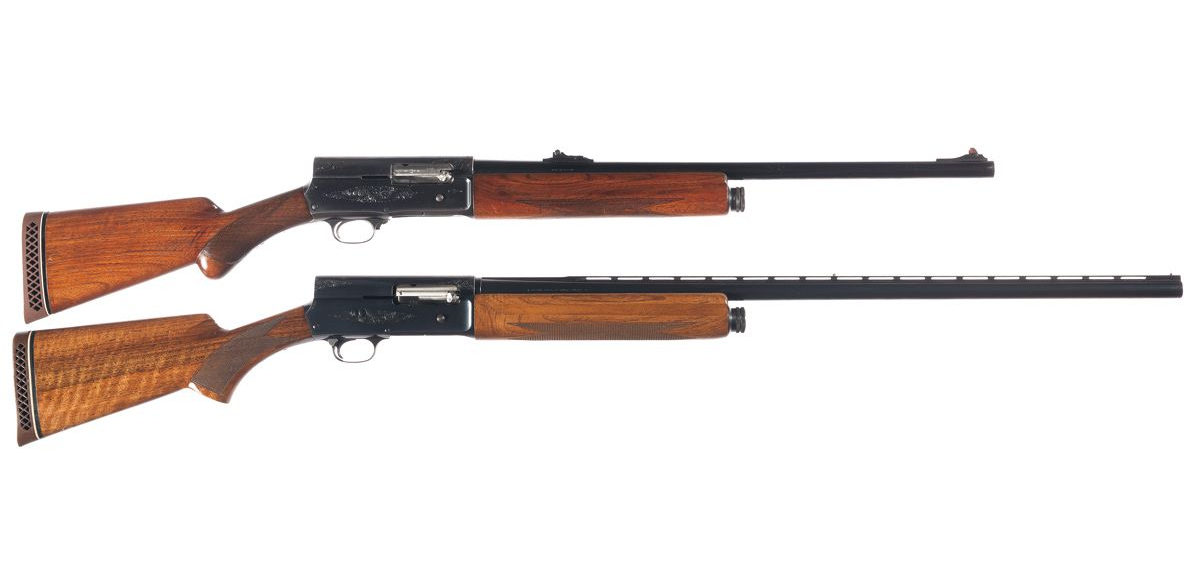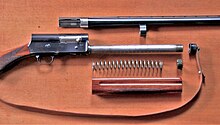
Browning Auto-5
| Remington Model 11/Browning Auto-5 | |
|---|---|
 |
|
| Type | Semi-automatic shotgun |
| Place of origin | United States |
| Service history | |
| In service | 1905–1975 |
| Used by | See Users |
| Wars | Malayan Emergency[1] Rhodesian Bush War[2] |
| Production history | |
| Designer | John Browning |
| Designed | 1898 |
| Manufacturer | Browning Arms Fabrique Nationale Herstal (Belgique) Remington Arms Savage Arms Miroku Corp. |
| Produced | 1902–1998 |
| Variants | Remington Model 11, Savage Model 720 and Model 745 |
| Specifications | |
| Weight | 4.1 kilograms (9.0 lb) |
| Length | 127 centimetres (50 in) |
| Barrel length | 71.1 centimetres (28.0 in) [3] |
|
|
|
| Cartridge | 12 gauge, 16 gauge, 20 gauge |
| Action | Semi-automatic |
| Feed system | Two or four round tubular magazine, plus 1 in the chamber |
The Browning Automatic 5, most often Auto-5 or simply A-5, is a recoil-operatedsemi-automatic shotgun designed by John Browning. It was the first successful semi-automatic shotgun design, and remained in production until 1998. The name of the shotgun designates that it is an autoloader with a capacity of five rounds, four in the magazine and one in the chamber. Remington Arms sold a variant called the Remington Model 11 that was nearly identical but lacked the magazine cutoff found on the Browning.
History[edit]
The Browning Auto-5 was the first mass-produced semi-automatic shotgun. Designed by John Browning in 1898 and patented in 1900,[4] it was produced continually for almost 100 years by several makers with production ending in 1998. It features a distinctive high rear end, earning it the nickname “Humpback”. The top of the action goes straight back on a level with the barrel before cutting down sharply towards the buttstock. This distinctive feature makes it easy to identify A-5s from a distance. A-5s were produced in a variety of gauges, with 12 and 20 predominating; 16 gauge (not produced between 1976 and 1987) models were also available. The gun saw military service worldwide between World War I and the Vietnam War. A Remington Model 11 was used in the suicide of Kurt Cobain.[5]
Production[edit]
John Browning presented his design (which he called his best achievement)[4] to Winchester, where he had sold most of his previous designs. When Winchester refused his terms, Browning went to Remington. Tragically, the president of Remington died of a heart attack as Browning waited to offer them the gun. This forced Browning to look overseas to produce the shotgun. It was manufactured by FN (a company that had already produced Browning-designed pistols) starting in 1902. Browning would later license the design to Remington, which produced it as their Model 11 (1905–1947). The Remington Model 11 was the first auto-loading shotgun made in the USA. Savage Arms also licensed the design from Browning and produced it as their model 720 from 1930 to 1949, and their model 745 with an alloy receiver and two-shot magazine from 1941 to 1949. Browning’s long-recoil design itself served as the operating system for subsequent Remington (11-48), Savage (755, 775) and Franchi (AL-48) models.[4]
Production of the Auto-5 in Belgium continued until the start of World War II, when Browning moved production to Remington Arms in the United States. The Auto-5 was produced by Remington alongside the Model 11 until FN could resume making the gun after the war.[6] Unlike the Remington Model 11, the Remington-produced Browning shotguns had magazine cutoffs. Some 850,000 Remington Model 11 shotguns were produced before production ended in 1947. In 1952, production of Browning models returned to FN, where it continued until the end. However, the majority of production moved to the Japanese company Miroku in 1975. Finally, in 1998, manufacture of A-5s ceased except for a few commemorative models created at FN in 1999. As of 1983 it was well established as the second-best-selling auto-loading shotgun in U.S. history, after the Remington 1100.[4]
In 2014 Browning released the A5, a recoil-operated shotgun with external resemblance to the Auto 5, which is being manufactured in Belgium, assembled in Portugal.
Design details[edit]
The Browning Auto-5 is a long-recoil operated semi-automatic shotgun. Shells are stored in a tubular magazine under the barrel. When a chambered shell is fired, the barrel and bolt recoil together (for a distance greater than the shell length) and re-cock the hammer. As the barrel returns forward to its initial position the bolt remains behind and thus the spent shell is ejected through a port on the top of the receiver. Then the bolt returns forward and feeds another shell from the magazine into the action. This type of long recoil action was the first of its kind and patented in 1900 by John Browning.
To load the gun, shells are fed into the bottom of the action, where they are pushed into the tubular magazine. Most A-5s have removable plugs in the magazine which prevent more than three shells from being loaded (two in the magazine, plus one in the chamber) to comply with U.S. Federal migratory waterfowl laws, as well as some state hunting regulations. With the plug removed, the total capacity is five rounds. If the chamber is open (the operating handle is drawn back) the first shell loaded into the magazine tube will go directly into the chamber (there is a manual bolt closing button under the ejection port), the bolt then closes, and all further shells fed into the gun go into the magazine.
The A-5 has a system of friction piece or pieces and bevel rings which retard the barrel’s rearward travel. Setting these rings correctly is vital to good shotgun performance and to ensure a long life to the weapon, by controlling excessive recoil. The friction rings are set based on the type of load to be fired through the gun. Different settings can be found in the owner’s manual.[7][8]


